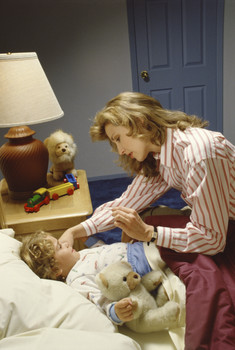Infection Control: When to Exclude Children from Daycare or School
Mild illness is common among children. Most children will not need to be excluded from school or their usual 
However, during the course of an identified outbreak of any communicable illness in a childcare setting or school, a child determined to be contributing to transmission of organisms causing the illness may be excluded. In general, the child may be readmitted when the risk of transmission is determined no longer to be present.
Children should be kept out of the childcare setting or school for the following:
- Illness that prevents the child from participating comfortably in common program activities
- Illness that results in a need for care that is greater than the staff can provide without compromising the health and safety of the other children
-
Any of the following conditions suggesting possible severe illness:
- fever accompanied by behavior changes
- lethargy
- irritability
- persistent crying
- difficult breathing
- other manifestations of possible severe illness, such as a quickly spreading rash
- Diarrhea that contains blood or mucus
- Mouth sores associated with drooling, unless the child’s physician or local health department authority states that the child is non-infectious
- Persistent abdominal pain (continues for longer than 2 hours) or intermittent abdominal pain associated with fever or dehydration
- Rash with fever or behavioral change, until a physician has determined the illness is not a communicable disease
- Vomiting 2 or more times during the previous 24 hours, unless the vomiting is determined to be caused by a non-communicable condition and the child is not in danger of dehydration
- Purulent conjunctivitis (defined as pink or red conjunctiva with white or yellow eye discharge, often with matted eyelids after sleep and eye pain or redness of the eyelids or skin surrounding the eye), until examined by a physician and approved for readmission
- Shiga toxin-producing Escherichia coli, including E. coli O157:H7, or Shigella infection, until diarrhea resolves and results of 2 stool cultures are negative for these organisms
- Head lice (pediculosis), at the end of the program or school day and until after the first treatment
- Hepatitis A virus infection, until 1 week after onset of illness or jaundice (if symptoms are mild)
- Impetigo, until 24 hours after treatment has been initiated
- Measles, until 4 days after onset of rash
- Mumps, until 9 days after onset of parotid gland swelling
- Pertussis, until 5 days of appropriate antimicrobial therapy have been completed
- Rubella, until 6 days after onset of rash
- Salmonella infection, until diarrhea resolves and 3 stool cultures test negative for Salmonella typhi; other types of Salmonella infection do not require negative stool culture results
- Scabies, until after treatment has been given
- Strep throat (Streptococcal pharyngitis), until 24 hours after treatment has been initiated
- Tuberculosis, until the child’s physician or local health department authority states that the child is non-infectious
- Varicella (chicken pox), until all lesions have dried and crusted (usually 6 days after initial onset of rash)
Most minor illnesses do not constitute a reason for excluding a child from childcare. Examples of illnesses and conditions that do not necessitate exclusion include the following:
- Non-purulent conjunctivitis (defined as pink conjunctiva with a clear, watery eye discharge without fever, eye pain, or eyelid redness)
- Cytomegalovirus (CMV) infection
- Chronic hepatitis B virus (HBV) infection
- Human immunodeficiency virus (HIV) infection
- Parvovirus B19 infection (Fifth disease) in an immunocompetent and otherwise healthy host
- Rash without fever and without behavioral change
Asymptomatic children with mild loose stools usually do not need to be excluded, except when an infection with Shiga toxin-producing E. coli or with Shigella species has occurred in the child care program or school. Because these infections are transmitted easily and can be severe, exclusion is warranted until results of 2 stool cultures are negative for the organism.
Source: Recommendations for Inclusion or Exclusion, American Academy of Pediatrics Red Book 2006: pages 133-135.
For Parents:
School and Illness: Should Your Child Stay Home? (pdf)
For more information:
Go to the Children’s Health health topic.